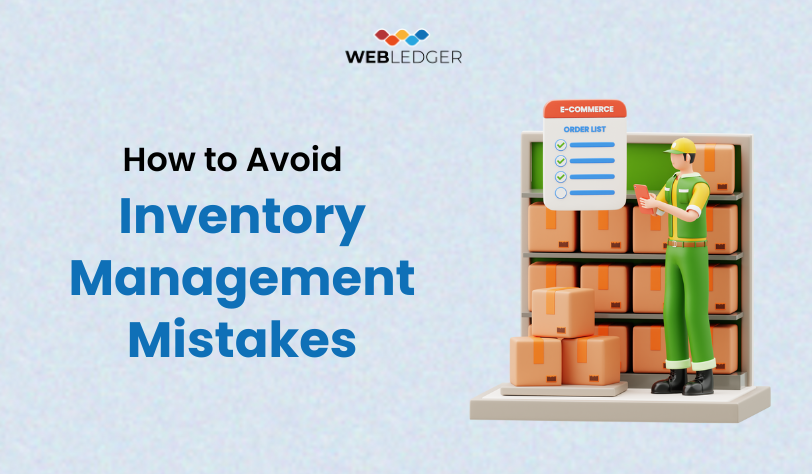Avoid inventory management Mistakes
It’s not hard to lose one’s way in the fast-paced world of business. If your inventory becomes unorganised, it can convert into larger issues. Loss of sales and money wasted are just two examples of how your profits and business reputation can be impacted.
The good news is, you can prevent this! By using the proper techniques and tools, you can better control your inventory, enhance your operations, and maintain a smooth-running business.
At WebLedger Books, we realise just how valuable inventory control is to your business success. That’s why we developed features that give you clear visibility into your inventory. Before we discuss how WebLedger assists, let’s discuss some mistakes in inventory management and how to prevent them.
The Hidden Costs of Poor Inventory Control: Are You Making These Stock Mistakes?
Most companies, particularly small and medium-sized ones, are unaware of the actual cost of inefficient inventory management. It’s not merely a question of selling out on a bestseller; the implications can go far beyond that:
- Lost Sales and Disappointed Customers: Picturing the buyer who’s about to make a purchase, only to discover you’re out of stock. You’ve lost the sale and potentially the loyal customer to a competitor. This is among the most infuriating stock blunders.
- Tied-Up Capital: Each product on your shelves is money that is unavailable to spend on something else. Too much inventory ties up precious working capital, decreasing your cash flow and constraining your ability to capitalise on new opportunities.
- Increased Storage Costs: Additional inventory requires more space. Additional space usually translates into greater rent, insurance, and utility expenses.
- Spoilage, Obsolescence, and Damage: Perishables go bad, fashion becomes obsolete, and even durable goods suffer damage in storage. Stale, unused, or damaged stock results in direct losses.
- Inefficient Operations: On-going searching for products, handling misplaced stock, and making rush orders waste precious time and resources.
- Inaccurate Reporting: Inaccurate records for your inventory can result in messy financial reports. This complicates it to know your actual profitability and affects your decision-making and tax reporting.
- Decreased Profit Margins: All these contribute to eating away at your profits, making it more difficult to be competitive and expand your business.
Taking Charge: Key Strategies for Effective Inventory Control
Now that we’ve covered the issues let’s talk about practical solutions you can implement to avoid them and establish sound inventory control.
Better Accounting
Please enter the OTP below to proceed.
-
Familiarise Yourself with Your Inventory: The Foundation of Product Management
What you don’t know cannot be managed. Understanding each product in your inventory is the starting point for efficient inventory management.
- Group and Organise: Put similar items in groups. With WebLedger, it’s simple to create Item Groups to organise your catalog and generate valuable reports. For instance, have all your stationery products in one group and electronics in another.
- Item Details: Maintain detailed details of each item. This should have descriptions, supplier information, cost, selling price, and distinct identifiers such as SKUs (Stock Keeping Units). WebLedger enables you to create items as goods or services, which has flexibility for various types of businesses.
- Units of Measurement (UOM): Use precise UOMs to monitor your stock. Counting individual units, dozens, kilograms, or litres, standardising your UOMs prevents confusion and enables proper counting. WebLedger accommodates many different UOMs to suit your company’s requirements.
- Item Series for Single Unit Tracking: If your company is selling serialised products (such as electronics or machinery), tracking single units is crucial. WebLedger’s Item Series function allows you to apply specific identifiers to each product, so you have improved control and trackability. This is particularly helpful for warranty tracking, return processing, and finding individual units.
-
Perform Regular Inventory Counts: The Secret to Accuracies
Even top-notch systems require occasional physical counts to ensure your computerised records correspond to your actual inventory.
- Cycle Counting: Rather than conduct one large annual count, apply cycle counting. Count a small segment of your inventory on a regular basis (daily, weekly, or monthly). It’s less intrusive and will allow you to detect discrepancies earlier, meaning more accuracy in the long run.
- Spot Checks: Periodically do random audits of high-dollar or quick-movers to detect any discrepancies earlier. This enforces good habits.
- Fix Discrepancies: When you do discover a discrepancy, determine why it occurred. Was it because of an error in receiving, incorrect shipment, or theft? Knowing why will avoid repetitions.
-
Forecast Demand Accurately: Avoiding Stockouts and Overstocking
Effective forecasting allows you to anticipate customer demand and modify your buying.
- Analyse Historical Data: Examine historic sales, seasonal patterns, and the impact of promotions. Reports through WebLedger can provide insights into your sales trend.
- Consider External Factors: Consider future promotions, marketing campaigns, economic trends, and competitor actions that could affect demand.
- Involve Sales and Marketing: Your sales and marketing staff tend to have good ideas about the needs of customers in the future and what is happening in the market. Engage them in your demand forecasting.
-
Optimise Your Ordering Process: The Reordering Art
Using precise demand forecasts, you can optimise your ordering process to have just the right quantity of inventory.
- Set Reorder Points (ROP): This is the threshold level of an item that you should keep in hand prior to ordering again. When your inventory hits this level, a new order is initiated.
- Formula: ROP = (Daily Usage * Lead Time in Days) + Safety Stock.
- Lead Time: Time taken to receive goods once an order is placed.
- Safety Stock: A safeguard against unforeseen demand or delayed deliveries.
- Calculate Economic Order Quantity (EOQ): EOQ is the optimum order quantity that optimises the total cost of inventory (holding costs + ordering costs). Knowing it optimises order sizes.
- Build Strong Supplier Relationships: Reliable suppliers are essential. Communicate regularly and negotiate good terms to ensure timely deliveries.
- Automate When Possible: Many inventory management systems, including WebLedger, can automate reorder notifications when stock levels reach their reorder point.
-
Streamline Receiving and Dispatch Processes: Avoiding Errors
Mistakes during receiving and sending out goods can quickly lead to wrong inventory records.
- Standard Procedures: Use clear, documented steps for receiving, inspecting, and storing incoming goods.
- Quality Checks: Review incoming goods for damage or discrepancies to purchase orders.
- Timely Recording: Have all outgoing and incoming inventory recorded promptly and accurately.
-
Using Technology to Assist with Product Management
It’s easy to make errors, time-consuming, and not feasible for most companies to manage inventory manually. That is where accounting and inventory software such as WebLedger Books can assist.
- Centralised Data: WebLedger provides you with a single point to organise all your inventory data, which reduces errors and inconsistencies.
- Real-Time Visibility: You receive a current view of your inventory levels, which enables you to make rapid and informed decisions.
- Automated Reporting: It is simple to create key inventory reports. WebLedger does this particularly well:
- Inventory Summary: Our comprehensive summary report displays a summary of your stock, including
- Opening Balance: The value, rate, and quantity of your inventory at the beginning of a period.
- Inward Inventory: Details of all the goods received, such as quantity, rate, and value.
- Outward Inventory: Details of all the goods that went out (sales, transfers, etc.), such as quantity, rate, and value.
- Closing Balance: The quantity, rate, and value of the current inventory, providing you with a clear picture at the end of the desired period.
This breakdown helps you track movements, check stock levels, and spot problems before they grow.
Tracking Individual Items with Item Series
If you need to track specific items, our Item Series feature allows you to see exactly where a product is, when you received it, and when it left your business. This is especially helpful for high-value goods or items with warranties.
Why WebLedger Books is Your Inventory Control Partner
WebLedger believes that controlling products must be easy. Our application has a user-friendly interface, so you can manage your inventory even if you’re not an accounting professional.
We give you transparent reports from your catalogue details, such as Item Group, UOM, and Item Series. This enables you to:
- Minimise Stock Errors: With the right data, you’re less likely to be overstocked, understocked, or lose stock.
- Maximise Cash Flow: By controlling your inventory levels effectively, you can free up cash to invest in your expansion.
- Maximise Customer Satisfaction: Having the correct products in stock translates to fewer missed sales and better-natured customers.
- Maximise Operating Efficiency: Waste less time searching for things and more time expanding your business.
- Make Better Decisions: Detailed inventory reports give you insights to help with smart purchasing and sales choices.
Read More: Top 7 Signs Your Business Needs an Inventory Management System
Conclusion
Inventory management mistakes is a common problem, but you can overcome it with the right strategies and tools. Focus on using accurate data, implement consistent processes, use technology for inventory control, and know your reorder points. These steps can help you turn your inventory from a liability into a valuable asset.
Want to get in charge of your inventory and make your business run more smoothly? Look no further than WebLedger Books today and find out how our easy features can save you from expensive stock errors and get your products under control!




